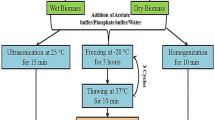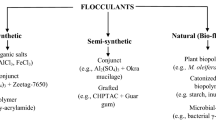Abstract
The fruit of Randia echinocarpa is commonly used in the Mexican traditional medicine to treat different diseases and ailments. The establishment of cell suspension cultures (CSC) is a viable alternative to obtaining bioactive compounds from this plant. Moreover, suitable kinetic models are necessary for optimal process control and simulation of plant cell cultures. Therefore, the objectives of this study were to model and estimate the growth kinetics of the CSC of R. echinocarpa, as well as characterize their phenolic profile by ultra-performance liquid chromatography coupled with mass spectrometry. Along the 34 d of culture, CSC of R. echinocarpa reached a dry cell biomass concentration of 15.16 g/L at day 20. The maximum specific growth rate (\({\mu }_{max}\)) was 0.15 d−1, with a duplication time (\({t}_{d}\)) of 4.62 d. The Logistic model adequately predicted the cell growth changes during the culture and the maximum dry cell content that the culture medium could sustain (≈ 13.63 g/L). Ten phenolic compounds were identified in the biomass and four in the supernatants. The major phenolic compound in the biomass was chlorogenic acid (CA), with a concentration of 828.6 μg/g at day 20. In the lyophilized supernatant, the major phenolic compound was salicylic acid (SA) with a concentration of 172.7 μg/g at day 30. The production of CA was a growth-dependent process in contrast to the concentration of SA in the media. Our results indicate that CSC of R. echinocarpa could be a sustainable source to produce bioactive compounds such as CA and SA.
Key message
This study describes the kinetic parameters of cell suspensions of R. echinocarpa using a mathematical model and evaluates the phenolic profiles of these cultures.




Similar content being viewed by others
Data availability
Data will be made available on reasonable request.
References
Arya SS, Rookes JE, Cahill DM, Lenka SK (2020) Next-generation metabolic engineering approaches towards development of plant cell suspension cultures as specialized metabolite producing biofactories. Biotech Adv. https://doi.org/10.1016/j.biotechadv.2020.107635
Begum S, Khan T, Khan MA, Zahoor M, Zaman N, Ali W (2023) Carbon nanotubes-mediated production of biomass and phenolic compounds in callus cultures of Fagonia indica. Ind Crops Prod. https://doi.org/10.1016/j.indcrop.2023.116408
Behrend J, Mateles RI (1975) Nitrogen metabolism in plant cell suspension cultures: I. Effect of amino acids on growth. Plant Physiol 56(5):584–589. https://doi.org/10.1104/pp.56.5.584
Bernabé-Antonio A, Sánchez-Sánchez A, Romero-Estrada A, Meza-Contreras JC, Silva-Guzmán JA, Fuentes-Talavera FJ, Hurtado-Díaz I, Alvarez L, Cruz-Sosa F (2021) Establishment of a cell suspension culture of Eysenhardtia platycarpa: Phytochemical screening of extracts and evaluation of antifungal activity. Plants 10(2):414. https://doi.org/10.3390/plants10020414
Cano-Campos MC, Díaz-Camacho SP, Uribe-Beltran M, López-Angulo G, Montes-Avila J, Paredes-López O, Delgado-Vargas F (2011) Bio-guided fractionation of the antimutagenic activity of methanolic extract from the fruit of Randia echinocarpa (Sessé et Mociño) against 1-nitropyrene. Food Res Int 44(9):3087–3093. https://doi.org/10.1016/j.foodres.2011.08.006
Cortés F (2000) Medicine, myths and magic the folk healers of a Mexican market. Econ Bot 54:427–438. https://doi.org/10.1007/BF02866542
Cuevas-Juárez E, Yuriar-Arredondo KY, Pío-León JF, Montes-Avila J, López-Angulo G, Díaz-Camacho SP, Delgado-Vargas F (2014) Antioxidant and α-glucosidase inhibitory properties of soluble melanins from the fruits of Vitex mollis Kunth, Randia echinocarpa Sessé et Mociño and Crescentia alata Kunth. J Funct Foods 9:78–88. https://doi.org/10.1016/j.jff.2014.04.016
de la Rosa LA, Moreno-Escamilla JO, Rodrigo-García J, Alvarez-Parrilla E (2019) Phenolic compounds. Phenolic compounds. In: Yahia EM (ed) Postharvest physiology and biochemistry of fruits and vegetables, 1st edn. pp 253–272. https://doi.org/10.1016/B978-0-12-813278-4.00012-9
Dempsey DMA, Vlot AC, Wildermuth MC, Klessig DF (2011) Salicylic acid biosynthesis and metabolism. Arabidopsis Book. https://doi.org/10.1199/tab.0156
Dias MI, Sousa MJ, Alves RC, Ferreira IC (2016) Exploring plant tissue culture to improve the production of phenolic compounds: A review. Ind Crops Prod 82:9–22. https://doi.org/10.1016/j.indcrop.2015.12.016
Dubois M, Gilles KA, Hamilton JK, Rebers PT, Smith F (1956) Colorimetric method for determination of sugars and related substances. Anal Chem 28(3):350–356. https://doi.org/10.1021/ac60111a017
Efferth T (2019) Biotechnology applications of plant callus cultures. Engineering 5(1):50–59. https://doi.org/10.1016/j.eng.2018.11.006
Guan H, Luo W, Bao B, Cao Y, Cheng F, Yu S, Fan Q, Zhang L, Wu Q, Shan M (2022) A comprehensive review of rosmarinic acid: From phytochemistry to pharmacology and its new insight. Molecules 27(10):3292. https://doi.org/10.3390/molecules27103292
Guardiola J, Iborra JL, Canovas M (1995) A model that links growth and secondary metabolite production in plant cell suspension cultures. Biotech Bioeng 46(3):291–297. https://doi.org/10.1002/bit.260460313
Haida Z, Syahida A, Ariff SM, Maziah M, Hakiman M (2019) Factors affecting cell biomass and flavonoid production of Ficus deltoidea var. kunstleri in cell suspension culture system. Sci Rep 9(1):1–8. https://doi.org/10.1038/s41598-019-46042-w
Hesami M, Pepe M, Monthony AS, Baiton A, Jones AMP (2021) Modeling and optimizing in vitro seed germination of industrial hemp (Cannabis sativa L.). Ind Crops Prod. https://doi.org/10.1016/j.indcrop.2021.113753
Juárez-Trujillo N, Monribot-Villanueva JL, Alvarado-Olivarez M, Luna-Solano G, Guerrero-Analco JA, Jiménez-Fernández M (2018) Phenolic profile and antioxidative properties of pulp and seeds of Randia monantha Benth. Ind Crops Prod 124:53–58. https://doi.org/10.1016/j.indcrop.2018.07.052
Kawano T, Wallbridge N, Plummer C (2020) Logistic models for simulating the growth of plants by defining the maximum plant size as the limit of information flow. Plant Signal Behav 15(2):1709718. https://doi.org/10.1080/15592324.2019.1709718
Khan T, Abbasi BH, Zeb A, Ali GS (2018) Carbohydrate-induced biomass accumulation and elicitation of secondary metabolites in callus cultures of Fagonia indica. Ind Crops Prod 126:168–176. https://doi.org/10.1016/j.indcrop.2018.10.023
Kim GD, Park YS, Jin YH, Park CS (2015) Production and applications of rosmarinic acid and structurally related compounds. Appl Microbiol Biotechnol 99:2083–2092. https://doi.org/10.1007/s00253-015-6395-6
Kundu A (2017) Vanillin biosynthetic pathways in plants. Planta 245:1069–1078. https://doi.org/10.1007/s00425-017-2684-x
Lefevere H, Bauters L, Gheysen G (2020) Salicylic acid biosynthesis in plants. Frontiers Plant Sci 11:338. https://doi.org/10.3389/fpls.2020.00338
Liu Z, Du L, Liu N, Mohsin A, Zhu X, Sun H, Zhou B, Yin Z, Zhuang Y, Guo M, Wang Z (2023) Insights into chlorogenic acids’ efficient biosynthesis through Carthamus tinctorius cell suspension cultures and their potential mechanism as α-glucosidase inhibitors. Ind Crops Prod. https://doi.org/10.1016/j.indcrop.2023.116337
Lu H, Tian Z, Cui Y, Liu Z, Ma X (2020) Chlorogenic acid: A comprehensive review of the dietary sources, processing effects, bioavailability, beneficial properties, mechanisms of action, and future directions. Compr Rev Food Sci Food Saf 19(6):3130–3158. https://doi.org/10.1111/1541-4337.12620
Luedeking R, Piret EL (1959) Transient and steady states in continuous fermentation. Theory and experiment. J Biochem and Microbiol Technol and Eng 1(4):431–459. https://doi.org/10.1002/jbmte.390010408
Marchev AS, Vasileva LV, Amirova KM, Savova MS, Koycheva IK, Balcheva-Sivenova ZP, Vasileva SM, Georgiev MI (2021) Rosmarinic acid-From bench to valuable applications in food industry. Trends Food Sci Technol 117:182–193. https://doi.org/10.1016/j.tifs.2021.03.015
Martínez-Ceja A, Romero-Estrada A, Columba-Palomares MC, Hurtado-Díaz I, Alvarez L, Teta-Talixtacta R, Sánchez-Ramos M, Cruz-Sosa F, Bernabé-Antonio A (2022) Anti-inflammatory, antibacterial and antioxidant activity of leaf and cell cultures extracts of Randia aculeata L. and its chemical components by GC-MS. South Afr J of Botany 144:206–218. https://doi.org/10.1016/j.sajb.2021.08.036
Montes-Avila J, Ojeda-Ayala M, López-Angulo G, Pío-León JF, Díaz-Camacho SP, Ochoa-Terán A, Delgado-Vargas F (2018) Physicochemical properties and biological activities of melanins from the black-edible fruits Vitex mollis and Randia echinocarpa. J Food Meas Charact 12:1972–1980. https://doi.org/10.1007/s11694-018-9812-6
Motolinía-Alcántara EA, Castillo-Araiza CO, Rodríguez-Monroy M, Román-Guerrero A, Cruz-Sosa F (2021) Engineering considerations to produce bioactive compounds from plant cell suspension culture in bioreactors. Plants 10(12):2762. https://doi.org/10.3390/plants10122762
Murashige T, Skoog F (1962) A revised medium for rapid growth and bioassays with tobacco tissue cultures. Physiol Plant 15(3):473–497. https://doi.org/10.1111/j.1399-3054.1962.tb08052.x
Nadeem M, Imran M, Aslam Gondal T, Imran A, Shahbaz M, Muhammad Amir R, Wasim Sajid M, Batool Qaisrani T, Atif M, Hussain G (2019) Therapeutic potential of rosmarinic acid: a comprehensive review. Appl Sci 9:3139. https://doi.org/10.3390/app9153139
Naveed M, Hejazi V, Abbas M, Kamboh AA, Khan GJ, Shumzaid M, Ahmad F, Babazadeh D, FangFang X, Modarresi-Ghazani F, WenHua L, XiaoHui Z (2018) Chlorogenic acid (CGA): A pharmacological review and call for further research. Biomed Pharmacother 97:67–74. https://doi.org/10.1016/j.biopha.2017.10.064
Ojeda-Ayala M, Gaxiola-Camacho SM, Delgado-Vargas F (2022) Phytochemical composition and biological activities of the plants of the genus Randia. Bot Scis 100(4):779–796
Omar R, Abdullah MA, Hasan MA, Rosfarizan M, Marziah M (2006) Kinetics and modelling of cell growth and substrate uptake in Centella asiatica cell culture. Biotechnol Bioproc Eng 11:223–229. https://doi.org/10.1007/BF02932034
Pan Y, Li L, Xiao S, Chen Z, Sarsaiya S, Zhang S et al (2020) Callus growth kinetics and accumulation of secondary metabolites of Bletilla striata Rchb. f. using a callus suspension culture. PLoS ONE. https://doi.org/10.1371/journal.pone.0220084
Pappis L, Ramos AP, Fontana T, Sangoi GG, Dornelles RC, Dolwitsch CB, Sagrillo MR, Cadoná FC, Machado AK, Bauermann LDF (2022) Randia ferox (Cham & Schltdl) DC.: phytochemical composition, in vitro cyto-and genotoxicity analyses. Nat Prod Res. https://doi.org/10.1080/14786419.2021.1960522
Petersen M (2013) Rosmarinic Acid: New Aspects. Phytochem Revs 12:207–227. https://doi.org/10.1007/s11101-013-9282-8
Rho D, André G (1991) Growth and stoichiometry of a Catharanthus roseus cell suspension culture grown under nitrogen-limiting conditions. Biotech Bioeng 38(6):579–587. https://doi.org/10.1002/bit.260380604
Sánchez-Ramos M, Alvarez L, Romero-Estrada A, Bernabé-Antonio A, Marquina-Bahena S, Cruz-Sosa F (2020) Establishment of a cell suspension culture of Ageratina pichinchensis (Kunth) for the improved production of anti-inflammatory compounds. Plants 9(10):1398. https://doi.org/10.3390/plants9101398
Santos-Cervantes ME, Ibarra-Zazueta ME, Loarca-Piña G, Paredes-López O, Delgado-Vargas F (2007) Antioxidant and antimutagenic activities of Randia echinocarpa fruit. Plant Foods Hum Nutr 62:71–77. https://doi.org/10.1007/s11130-007-0044-x
Schlatmann JE, Ten Hoopen HJG, Heijnen JJ (1999) A simple structured model for maintenance, biomass formation, and ajmalicine production by nondividing Catharanthus roseus cells. Biotech Bioeng 66(3):147–157. https://doi.org/10.1002/(SICI)1097-0290(1999)66:3%3C147::AID-BIT2%3E3.0.CO;2-N
Srinivasan V, Pestchanker L, Moser S, Hirasuna TJ, Taticek RA, Shuler ML (1995) Taxol production in bioreactors: kinetics of biomass accumulation, nutrient uptake, and taxol production by cell suspensions of Taxus baccata. Biotech Bioeng 47(6):666–676. https://doi.org/10.1002/bit.260470607
Tuskan GA, Mewalal R, Gunter LE, Palla KJ, Carter K, Jacobson DA, Jones PC, Garcia BJ, Weighill DA, Hyatt PD, Yang Y, Zhang J, Reis N, Chen JG, Muchero W (2018) Defining the genetic components of callus formation: A GWAS approach. PLoS ONE. https://doi.org/10.1371/journal.pone.0202519
Valenzuela-Atondo DA, Delgado-Vargas F, López-Angulo G, Calderón-Vázquez CL, Orozco-Cárdenas ML, Cruz-Mendívil A (2020) Antioxidant activity of in vitro plantlets and callus cultures of Randia echinocarpa, a medicinal plant from northwestern Mexico. In Vitro Cell Dev Biol-Plant 56:440–446. https://doi.org/10.1007/s11627-020-10062-3
Van Gulik WM, Ten Hoopen HJG, Heijnen JJ (1992) Kinetics and stoichiometry of growth of plant cell cultures of Catharanthus roseus and Nicotiana tabacum in batch and continuous fermentors. Biotech Bioeng 40(8):863–874. https://doi.org/10.1002/bit.260400802
Villegas A, Arias JP, Aragón D, Ochoa S, Arias M (2017) First principle-based models in plant suspension cell cultures: a review. Crit Rev Biotechnol 37(8):1077–1089. https://doi.org/10.1080/07388551.2017.1304891
Waterhouse AL (2002) Determination of total phenolics. Curr Protoc in Food Analytical Chem 6(1):I1-1. https://doi.org/10.1002/0471142913.fai0101s06
Wawrosch C, Zotchev SB (2021) Production of bioactive plant secondary metabolites through in vitro technologies—status and outlook. Appl Microbiol Biotechnol 105(18):6649–6668. https://doi.org/10.1007/s00253-021-11539-w
Weatherburn MW (1967) Phenol-hypochlorite reaction for determination of ammonia. Analytical Chem 39(8):971–974. https://doi.org/10.1021/ac60252a045
Zhang CY, Dong YS, Li YL, Fu CH, Zhao CF, Yu LJ (2013) Unstructured models for suspension cultures of Taxus media cells in a bioreactor under substrate-sufficient conditions. Biochem Eng J 71:62–71. https://doi.org/10.1016/j.bej.2012.11.014
Acknowledgements
The authors thank CIIDIR-IPN Sinaloa Unit for providing the Randia echinocarpa seeds.
Funding
This work was financially supported by the “Consejo Nacional de Ciencia y Tecnologia (CONACyT)” for the scholarship 2019–000037-02NACF-07262 and by the “Instituto Tecnológico de Estudios Superiores de Monterrey”.
Author information
Authors and Affiliations
Contributions
Miguel Aguilar-Camacho: Conceptualization, experimental work, data analysis, writing—original draft. Carlos Eduardo Gómez-Sanchez, Abraham Cruz-Mendívil, José A Guerrero-Analco, Juan L. Monribot-Villanueva: support during experimental work and formal analysis. Janet A. Gutiérrez-Uribe: conceptualization, funding acquisition, experimental design, project administration, supervision, manuscript review and edition.
Corresponding author
Ethics declarations
Conflict of interest
The authors have not disclosed any competing interests.
Ethical statement
The authors have no competing interests to declare that are relevant to the content of this article.
Additional information
Communicated by Melekşen Akın.
Publisher's Note
Springer Nature remains neutral with regard to jurisdictional claims in published maps and institutional affiliations.
Rights and permissions
Springer Nature or its licensor (e.g. a society or other partner) holds exclusive rights to this article under a publishing agreement with the author(s) or other rightsholder(s); author self-archiving of the accepted manuscript version of this article is solely governed by the terms of such publishing agreement and applicable law.
About this article
Cite this article
Aguilar-Camacho, M., Gómez-Sánchez, C.E., Cruz-Mendívil, A. et al. Modeling the growth kinetics of cell suspensions of Randia echinocarpa (Rubiaceae) and characterization of their bioactive phenolic compounds. Plant Cell Tiss Organ Cult 155, 785–796 (2023). https://doi.org/10.1007/s11240-023-02599-z
Received:
Accepted:
Published:
Issue Date:
DOI: https://doi.org/10.1007/s11240-023-02599-z




